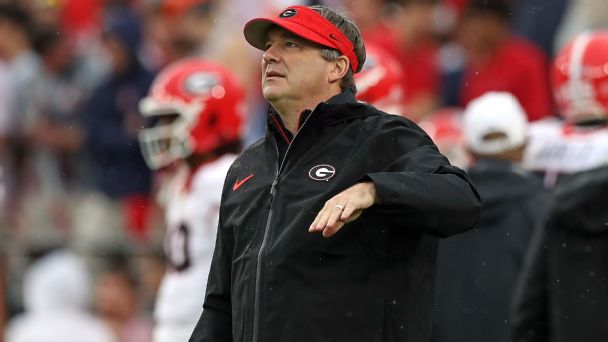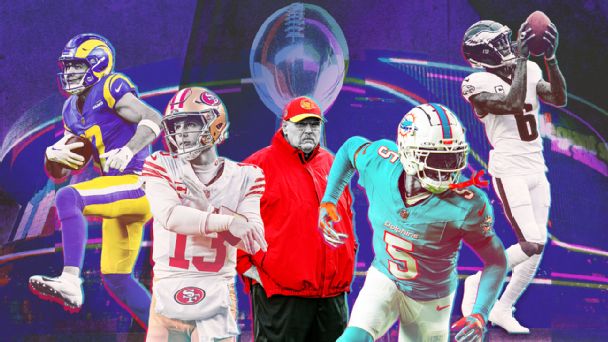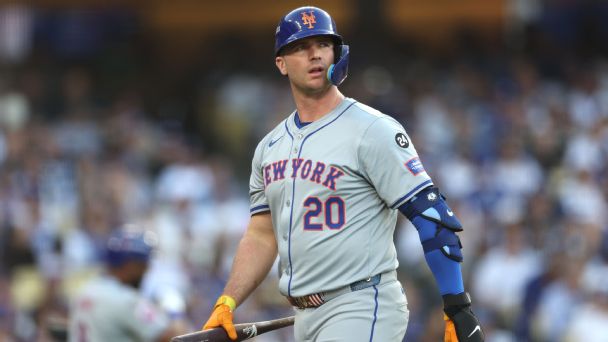![Deebo Samuel [608x342]](https://a.espncdn.com/photo/2024/1114/r1414920_608x342_16-9.jpg)
I take full responsibility Bears coach Matt Eberflus has struggled with staff turnover
Every offseason, a couple of big-name NFL players are released or traded, and the general reaction is shock. Why would they cut that guy? But those of us who cover the league and study contract math know those moves aren't always quite as surprising as they appear to be on the surface. So with that in mind, we wanted to take our annual look at 10 players whose teams might decide to go in different directions during the 2025 offseason.
Maybe it's a player on a four-year contract where the guaranteed money ran out after two. Maybe it's a player who was drafted by a previous iteration of the team's front office and doesn't fit the new one's plan. There are plenty of reasons for a surprise offseason move-on.
Some disclaimers: As always, this is not designed to be a comprehensive list. And it's important to consider factors beyond just age, health and contracts. For example: When we did this exercise last season, Browns running back Nick Chubb would have been an obvious candidate, given that he was injured, turning 28 and carrying a large 2024 cap number. But to predict Chubb as an offseason release would have been to ignore his strong relationship with the team, which worked out a contract adjustment to keep him in Cleveland while he finished his rehab and returned to the field. I call this the "Cameron Heyward Rule" because it's a lesson I learned like three or four years ago when I included him on this list (yeah, he is still on the Steelers). Hey, you live and you learn.
Let's dive in on this partial list that points to 10 players whose respective teams might surprisingly choose to move on next spring, listed in no particular order.
Jump to a player on a team: BAL | BUF | CLE | LAC | NO NYJ | PHI | SF | SEA
Deebo Samuel Sr., WR, San Francisco 49ersAn integral part of the 49ers' success during the Kyle Shanahan era, Samuel stands as an example of the difficult decisions San Francisco will confront in the spring. The team signed Brandon Aiyuk to a big-money contract extension before this season, extended Jauan Jennings earlier in the offseason and drafted Ricky Pearsall in the first round. So the Niners have spent considerable resources on their future at the wide receiver position. That leads one to believe Samuel could be the odd man out as they start to transition from their Super Bowl-caliber core into the future.
Samuel's contract structure is interesting. He'll make about $16.6 million next year, but about $15.4 million of that is in the form of an option bonus the team has to decide on before the 10th day of the league year in March. So the 49ers could trade him before that date, leaving his new team responsible for the 2025 cash -- but the Niners would carry a dead-money charge of $31.55 million on their 2025 cap. Releasing Samuel and designating him as a post-June 1 cut would allow them to defray that cost over two years, and if they do decide to move on, that's the more likely decision. (You can't designate someone as a "post-June 1 trade" -- you have to actually wait until after June 1 to trade him if you want to break up the cap hit.)
Again, Samuel -- who has 29 catches for 468 yards this season -- is an avatar here. Longtime 49ers such as Trent Williams, Fred Warner, George Kittle and Javon Hargrave are all reaching ages and/or contract seasons in which the team has to think about how much longer they'll be there. The outcomes of all of these situations could depend on the way the rest of this season goes for San Francisco, but just don't be surprised if you start to see a little bit of overhaul. And that's especially true at the receiver position, where a lot of the resources have gone to other players over the past calendar year.
Tyler Lockett, WR, Seattle SeahawksLockett is a candidate for the Heyward Rule, because of the love and respect the Seahawks have for him and all he has meant to them over his 10 years there. But Lockett -- who was also on this list last November -- is 32 years old and scheduled to make $17 million (non-guaranteed) in 2025, which is the final year of his current contract. The Seahawks are paying DK Metcalf big money, and 2023 first-round pick Jaxon Smith-Njigba will be entering his third season. They're also finishing up the first year with a new coaching staff and offense; Lockett is third on the team with 34 receptions for 456 yards and two TDs.
Given their history together, we can't rule out the possibility of the Seahawks finding a way to keep Lockett on some kind of smaller contract for his age-33 season. But looking at this situation objectively, it feels as if the 2025 offseason is the time when this relationship sees its ending. The Seahawks would incur a 2025 dead-money cap charge of $13.895 million if they released Lockett or he retired. They could spread that out over two years if they designated him as a post-June 1 cut.
Derek Carr, QB, New Orleans SaintsWe already know the Saints will have a new coach in 2025, which means a new offensive coordinator and system -- and that often means a new quarterback. Carr turns 34 in March, and while QBs can certainly play into their late-30s and longer these days, it hasn't gone well enough for Carr in New Orleans that the Saints will definitely feel bound to keep him and build around him. He has 11 touchdown passes and four interceptions over seven games.
Carr and his agent, Tim Younger, built some solid protections into his contract, including a fully guaranteed $10 million roster bonus next year and a clause that fully guarantees his $30 million 2025 salary if he's still on the Saints' roster on the third day of the league year. So if the Saints are moving on, Carr knows he'll for sure get the $10 million and will know early enough that he can find work elsewhere before the free agent money dries up.
And who knows? Maybe Carr and the Saints finish the season strong without any receivers and decide to stay together. But more likely, Carr is looking for his third team by the middle of March, while the Saints are looking at the draft and free agency to find his replacement.
Joey Bosa, Edge, Los Angeles ChargersThe Chargers overhauled their wide receiver corps this past offseason, saying goodbye to long-timers Keenan Allen and Mike Williams. But they renegotiated the contracts of Bosa and Khalil Mack to keep both of their veteran edge rushers on the 2024 roster. As is often the case, though, those restructures were one-year fixes and result in questions about whether Bosa and/or Mack will be on the 2025 team.
Bosa turns 30 next July and is scheduled to make a non-guaranteed $25.36 million next season. Of that, $12.36 million is a roster bonus that has to be exercised at some point in March, so the Chargers will make this call early. They'd incur a little more than $11 million in dead money on their 2025 cap if they release him. (Mack's 2024 restructure resulted in a contract that voids at the end of this year and makes him a free agent ahead of his age-34 season.)
Despite being tied for fourth in sacks (31), don't be surprised if the Chargers focus on restocking at the edge rusher spots this coming offseason.
Marlon Humphrey, CB, Baltimore RavensBaltimore's first-round pick in the 2017 draft, Humphrey is now 28 years old and scheduled to make $18 million in 2025. Of that, $14 million is salary and $4 million is a roster bonus that's due on the fifth day of the league year in March. The Ravens drafted cornerback Nate Wiggins in the first round of this year's draft, too.
At the moment, Humphrey has four interceptions but is part of an underperforming defense that could need an overhaul in the offseason depending on how the rest of the season goes. Releasing him would cost Baltimore about $12.7 million in dead money if they do it before the roster bonus kicks in.
Davante Adams, WR, New York JetsThe circumstances that brought Adams to New York have been well chronicled, and if Aaron Rodgers is back as the Jets' quarterback in 2025, you have to think the chances of Adams still being there increase. So far, the duo have linked up for 20 catches, 206 yards and a score over four games. But even if Adams does return, it won't be on his current contract.
Adams' deal -- signed with the Raiders as a condition of his trade there from Green Bay in 2022 -- has two years left on it, but neither of them was designed to ever actually exist. He's scheduled to earn $36.25 million in salary and bonuses in each of 2025 and 2026, but none of that is guaranteed, and there's no way he's making that money from the Jets or anyone else at ages 32 and 33. The Jets reworked Adams' contract when they traded for him in October, so they have a roughly $8.4 million dead-cap charge for him in 2025 if they cut him.
Again, if they bring him back, it'll be on a drastically reworked contract that could reduce that dead-money number and push some of it into future years. But it's also not an amount that would make it difficult to move on. There is a ton of uncertainty around the 2025 Jets, from the owners box to the coaching offices to the quarterback position, so no prediction on this is really safe -- except, again, that there's no way Adams is getting $36.25 million next year.
Von Miller, Edge, Buffalo BillsIt's safe to say the Bills haven't got what they were hoping for with Miller's six-year contract from 2022. He had to take a pay cut this past offseason to stay on the team, and he served a four-game personal conduct policy suspension this season. He turns 36 in March.
Miller is a two-time Super Bowl champion and surefire Hall of Famer who doesn't have anything left to prove as an NFL player. He has reached the point where it's fair to wonder how much longer he will even want to play. Certainly, if the Bills can win the Super Bowl, giving Miller his third ring with three different teams, it sets up as a storybook ending for the No. 2 pick of the 2011 draft. But if that doesn't happen, there's a pretty good chance he and the Bills part ways in the offseason.
He's scheduled to earn $17.5 million in salary and bonuses in 2025, but none of that money is guaranteed, nor is any of the money on his deal for 2026 or 2027. It would cost the Bills just under $15.5 million in dead money on their 2025 cap to move on from Miller in the spring.
Bryce Huff, Edge, Philadelphia EaglesWhat? Didn't he just sign there? Yes, Huff was a high-profile free agent signing by the Eagles, who gave him a three-year, $51.1 million deal to lure him away from the Jets. Given the way the season has unfolded, Huff is certainly happy with that move. But are the Eagles happy with him? Huff played just 12% of their defensive snaps in Week 9, 20% in Week 10 and 22% in Week 11 (after averaging 44% over the first eight weeks). He has 2.5 sacks, 14 pressures and four quarterback hits, and he seems to be a lesser part of the pass-rush rotation than the Eagles hoped he would be when they signed him.
Now, he also has $16.75 million in guaranteed money coming in 2025, so the Eagles aren't likely to cut him. Instead, he's on here because, at age 26, he could be an appealing trade target for a team looking for edge rush help that thinks he'd fit better with them than he does in Philly.
Joel Bitonio, G, Cleveland BrownsCleveland's stalwart interior lineman -- his 93.9% pass block win rate ranks 12th among guards -- is in his 11th season and turned 33 last month. Bitonio has one year left on his contract and is scheduled to earn $15 million in 2025. However, all but $1.255 million of that is in the form of option and roster bonuses that the team has to decide on by March. If the Browns can avoid the bonus payments, they could release Bitonio in the offseason and take on about $14.5 million in dead money for 2025.
The Browns have bigger cap and cash problems -- more on that in a second -- but Bitonio has reached an age and contract inflection point where he and the team have to figure out how much longer he'll be there and how much he'll get paid in that time.
Deshaun Watson, QB, Cleveland BrownsWe close with one of the uniquely awful contract situations in the history of sports. Watson signed a fully guaranteed five-year, $230 million contract with the Browns as a condition of the trade that brought him to Cleveland from Houston in the 2022 offseason. He was suspended for the first 11 games of 2022 for personal conduct policy violations that the team knew about when it traded for him. Then he sat out 11 games because of a shoulder injury in 2023 and played only seven games this season before sustaining another season-ending injury (Achilles).
The Browns restructured the contract in each of the past two offseasons, meaning his projected salary cap number in 2025 is $72.935 million. They owe him a total of $92 million -- $46 million each year -- in fully guaranteed salary over the remaining two years of the deal. So if they cut him in the spring, they'd incur a dead-money charge of $172.734 million on their 2025 cap. For perspective, this year's total salary cap per team is $255.4 million, and the record for dead money for one player is the $85 million the Broncos took on after cutting Russell Wilson this year. That is less than half of what the Browns would have in dead money if they cut Watson.
Sure, they'd save $92 million of that if they could trade him, but I couldn't even keep a straight face while typing the possibility that any team would consider trading for that contract. And that's especially true given that Watson is last in the NFL in QBR this season (22.2) and managed five passing touchdowns over seven games before the injury.
On some level, if they think he can play at all, the Browns are better off keeping Watson around for the remainder of his contract and just dealing with the cost. But there comes a point when the negatives outweigh the positives and it's worth just eating the cost. Since the positives have been stuck close to or at zero for three years, one has to believe the Browns have reached that point. Designating him as a post-June 1 cut would allow them to spread the dead-money hit out over two years, and that's probably the best solution the Browns have right now.
It will hurt. It will set the franchise back years. It could cost people their jobs. But the mistake was made in 2022, and unfortunately, there's just no clean way out of it.







